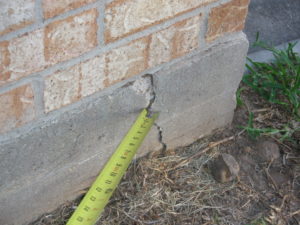If you walk around several homes in the Houston area you will notice most of the houses have a crack in at least one corner of the foundation. This crack usually will be 4 or 5 inches from the corner of the slab. Is that crack serious, is it a sign of foundation problems?
No, it is usually not a sign of a structural problem with the home’s foundation. It is caused by the thermo-expansion of the brick and that expansion of the brick, cracks the corner of the foundation.
First, let’s step back and let me explain what is behind this issue. Before the brick is layed on the brick ledge during the construction of the home, the cornice crew will put an 18 inch strip of plastic on top of the brick ledge and it will extend up the wall about 12 inches. This will be placed around the house everyplace the brick will touch the slab. This piece of plastic has a number of different purposes but the role it plays here, the brick and mortar is placed on top of the plastic so the mortar doesn’t adhere to the slab. The weight of the brick is bearing on the slab but the plastic doesn’t allow the mortar to adhere to the slab.
Therefore, during the day, as the sun heats up the brick, the brick will start to expand. Since the mortar isn’t sticking to the slab, the brick and mortar are free to slide over the plastic as the brick expands because the sun is warming it. At night the reverse happens, the brick will contract slightly as it cools. Again as the brick contracts, it will slide over the plastic.
O.K., if the brick is sliding on the plastic and not adhereing to the slab, what is causing the corner of the foundation to crack?
As the house is being built, the superintendent in charge of that house will ask the brick mason to trim off any plastic that is sticking out from under the brick after the brick mason finishes bricking the house. (Nobody likes to see an ugly strip of black plastic sticking out from between the brick and the slab.) This is a job that is a little bit difficult and after having to do that on a few houses, the brick mason will find an easier way! One of the shortcut taken by some is to cut the plastic short before the brick and mortar is layed. This will save the bricklayers from having to do it later and cutting it before is much easier. BUT, one of the purposes of the plastic is to keep the mortar from adhereing to the slab. Now that it has been trimmed back a little bit, some of the mortar will be able to adhere to the slab. As the brick is heated up during the day, it expands somewhat and the weak point is at the end of the wall – the corner. A small crack will develope over repeated heating and cooling cycles.
Again, this small crack is usually not structurally significant and generally nothing to worry about. About the only times that this situation needs action taken might be if the corner of the slab drops off and the brick that was being supported is now left unsupported and the brick starts to move downward.



I adored your intriguing blog. topnotch work. I hope you release others. I will carry on reading
Great article, We are asked to repair from our clients here in Houston, TX. They feel worried. I will have them refer to this article.
I enjoyed reading your article. Good job explaining things.
our corner has cracked as mentioned above, BUT…also the window about 3 ft from the corner slab, the brick has pulled away from the window frame , the entire length of the window, but only one side (of the window) just alittle bit. very concerned it may be more serious, plz advise. thank you.